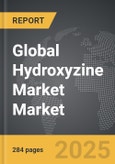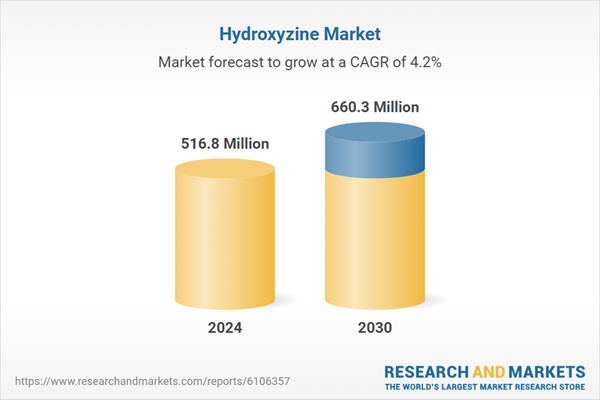Global Hydroxyzine Market - Key Trends and Drivers Summarized
Why Is Hydroxyzine a Widely Prescribed Medication in Modern Therapeutic Protocols?
Hydroxyzine has become a frequently utilized medication across various branches of clinical medicine due to its versatile pharmacological profile. Originally developed as an antihistamine, hydroxyzine has expanded in application and is now commonly prescribed not only for allergic reactions but also for anxiety, nausea, sleep disturbances, and pruritus. Its dual action as both an H1 receptor antagonist and a central nervous system depressant allows it to be effective in treating symptoms across multiple systems. Physicians often turn to hydroxyzine as a non-benzodiazepine alternative for patients who require short-term relief from anxiety or agitation, particularly those with a history of substance abuse where traditional anxiolytics may pose a higher risk. It is also commonly prescribed in preoperative settings to ease anxiety and produce mild sedation. In dermatology, hydroxyzine is favored for its antipruritic effects and ability to manage chronic urticaria and dermatitis-related itch. Furthermore, the medication's antiemetic properties make it useful for treating motion sickness and nausea related to chemotherapy or postoperative recovery. The wide range of indications and relatively low risk of addiction has made hydroxyzine a staple in outpatient and inpatient care settings alike. Its oral and intramuscular formulations offer flexibility depending on the urgency of treatment or the patient's ability to take medications orally. Pediatricians and geriatric specialists alike find hydroxyzine to be a valuable tool, provided it is used with appropriate dosing and monitoring. As healthcare providers increasingly look for medications that offer multi-symptom relief without the complex risk profiles of controlled substances, hydroxyzine remains an appealing choice in therapeutic planning.How Do Pharmacological Properties and Safety Profiles Influence Its Clinical Utility?
The pharmacological characteristics of hydroxyzine play a significant role in its ongoing popularity among clinicians. One of its most notable features is its ability to cross the blood-brain barrier and exert calming effects through modulation of activity in the central nervous system. Unlike traditional sedatives or anxiolytics that directly affect GABA receptors, hydroxyzine exerts its calming influence by antagonizing histamine receptors and reducing neuronal excitability. This unique mechanism allows it to deliver anxiolytic and sedative effects without the typical dependence and tolerance issues that often accompany benzodiazepines. The drug has a rapid onset of action, typically taking effect within 15 to 30 minutes after oral administration, which is particularly useful in acute anxiety episodes or allergic reactions. While hydroxyzine is generally well tolerated, certain precautions are necessary, especially in patients with liver or kidney impairment, since the drug is metabolized hepatically and excreted renally. Side effects such as drowsiness, dry mouth, dizziness, and occasionally blurred vision are common but typically mild and transient. Importantly, hydroxyzine does not interfere with cognitive or motor functions to the same extent as other sedatives, making it a safer option for individuals who must remain relatively alert. Cardiac monitoring may be advised in patients with known heart conditions due to the potential for QT interval prolongation in high doses or when combined with other medications. Its non-habit-forming nature adds to its value in long-term care environments where chronic symptom management is necessary. Overall, hydroxyzine's well-established safety profile, broad spectrum of action, and relatively low cost contribute to its enduring relevance in modern clinical practice.What Therapeutic Trends Are Shaping the Demand for Hydroxyzine in Global Healthcare?
Global trends in mental health awareness, chronic disease management, and multi-symptom therapy are all contributing to sustained demand for hydroxyzine. The increasing prevalence of anxiety disorders, driven by societal stress, economic instability, and post-pandemic mental health challenges, has led many healthcare providers to seek fast-acting, non-addictive alternatives to manage symptoms in diverse populations. Hydroxyzine fits this requirement, offering symptomatic relief with fewer concerns about misuse. At the same time, allergy-related conditions such as rhinitis, eczema, and hives are on the rise, particularly in urban environments with high pollution levels. The antihistamine properties of hydroxyzine make it a suitable option for patients requiring both allergic symptom control and relief from associated anxiety or insomnia. In oncology and palliative care settings, hydroxyzine is increasingly incorporated into supportive care protocols to manage nausea, vomiting, and general discomfort. Its dual utility in both physical and psychological symptom relief enhances its value in multidisciplinary treatment plans. Additionally, hydroxyzine's off-label use in treating certain behavioral symptoms, including agitation and irritability in patients with dementia or developmental disorders, is becoming more common. The growing shift toward personalized and integrative medicine is also pushing clinicians to adopt medications that address multiple symptoms with a single compound, minimizing polypharmacy risks. With healthcare systems focusing on cost-effective, broad-spectrum medications, hydroxyzine remains attractive for formulary inclusion. In many developing countries, where access to advanced psychiatric or dermatologic drugs may be limited, hydroxyzine serves as a reliable and affordable first-line option. These broader therapeutic trends are helping solidify its position as a core medication in both specialty and primary care environments.What Factors Are Contributing to the Continued Growth of the Hydroxyzine Market Globally?
The global hydroxyzine market is expanding due to a combination of clinical utility, affordability, regulatory support, and increasing healthcare demands across both developed and emerging markets. One major driver is the growing global burden of mental health conditions and allergic diseases, which require versatile treatment options that can be deployed quickly and safely. Hydroxyzine, with its multifaceted applications, has gained favor among practitioners who manage complex cases where patients present with overlapping symptoms. The affordability of hydroxyzine, particularly in its generic forms, makes it an accessible treatment option in public health systems and low-resource settings. Additionally, the widespread approval of hydroxyzine by regulatory bodies in numerous countries facilitates its distribution through both government-run healthcare programs and private providers. Pharmaceutical companies are continuing to invest in new formulations, including extended-release versions and combination therapies, to cater to evolving consumer preferences and clinical needs. The rise in telemedicine and digital prescribing platforms has also played a role, as medications like hydroxyzine that are widely understood and have a strong safety record are frequently chosen for remote prescriptions. Hospitals and outpatient clinics increasingly favor hydroxyzine in treatment protocols because of its predictable effects and compatibility with other therapies. In pediatric and geriatric care, where polypharmacy risks are higher, hydroxyzine's single-agent efficacy is a key advantage. Market growth is further supported by educational initiatives aimed at reducing the stigma associated with mental health treatment, which in turn is encouraging more individuals to seek medical support for anxiety, insomnia, and related conditions. As a result of these factors, hydroxyzine continues to see steady demand and market penetration globally, with prospects for sustained expansion as healthcare systems adapt to the rising need for comprehensive, accessible, and cost-effective pharmacological solutions.Report Scope
The report analyzes the Hydroxyzine market, presented in terms of market value (US$). The analysis covers the key segments and geographic regions outlined below:- Segments: Indication Type (Histamine-Mediated Pruritus Indication, Urticaria Indication, Atopic Contact Dermatitis Indication); Dosage Form (Tablets Dosage Form, Capsules Dosage Form, Injection Dosage Form, Syrup Dosage Form).
- Geographic Regions/Countries: World; United States; Canada; Japan; China; Europe (France; Germany; Italy; United Kingdom; Spain; Russia; and Rest of Europe); Asia-Pacific (Australia; India; South Korea; and Rest of Asia-Pacific); Latin America (Argentina; Brazil; Mexico; and Rest of Latin America); Middle East (Iran; Israel; Saudi Arabia; United Arab Emirates; and Rest of Middle East); and Africa.
Key Insights:
- Market Growth: Understand the significant growth trajectory of the Histamine-Mediated Pruritus Indication segment, which is expected to reach US$387.8 Million by 2030 with a CAGR of a 4.6%. The Urticaria Indication segment is also set to grow at 3.2% CAGR over the analysis period.
- Regional Analysis: Gain insights into the U.S. market, valued at $140.8 Million in 2024, and China, forecasted to grow at an impressive 7.7% CAGR to reach $135.6 Million by 2030. Discover growth trends in other key regions, including Japan, Canada, Germany, and the Asia-Pacific.
Why You Should Buy This Report:
- Detailed Market Analysis: Access a thorough analysis of the Global Hydroxyzine Market, covering all major geographic regions and market segments.
- Competitive Insights: Get an overview of the competitive landscape, including the market presence of major players across different geographies.
- Future Trends and Drivers: Understand the key trends and drivers shaping the future of the Global Hydroxyzine Market.
- Actionable Insights: Benefit from actionable insights that can help you identify new revenue opportunities and make strategic business decisions.
Key Questions Answered:
- How is the Global Hydroxyzine Market expected to evolve by 2030?
- What are the main drivers and restraints affecting the market?
- Which market segments will grow the most over the forecast period?
- How will market shares for different regions and segments change by 2030?
- Who are the leading players in the market, and what are their prospects?
Report Features:
- Comprehensive Market Data: Independent analysis of annual sales and market forecasts in US$ Million from 2024 to 2030.
- In-Depth Regional Analysis: Detailed insights into key markets, including the U.S., China, Japan, Canada, Europe, Asia-Pacific, Latin America, Middle East, and Africa.
- Company Profiles: Coverage of players such as ANDRITZ AG, BHEL (Bharat Heavy Electricals Ltd), Bluemec Hydro Inc., Canyon Hydro, China Gezhouba Group Corporation and more.
- Complimentary Updates: Receive free report updates for one year to keep you informed of the latest market developments.
Some of the 44 companies featured in this Hydroxyzine market report include:
- Amneal Pharmaceuticals, Inc.
- Apotex Inc.
- Aurobindo Pharma Ltd.
- Cadila Pharmaceuticals Ltd.
- Cipla Ltd.
- Dr. Reddy's Laboratories Ltd.
- Endo International plc
- Hikma Pharmaceuticals PLC
- Jubilant Pharmova Ltd.
- Lupin Limited
- Mylan N.V. (Viatris)
- Perrigo Company plc
- Pfizer Inc.
- Sandoz (a Novartis division)
- Sanofi
- Sun Pharmaceutical Industries Ltd.
- Teva Pharmaceutical Industries Ltd.
- Torrent Pharmaceuticals Ltd.
- Unichem Laboratories Ltd.
- Zydus Lifesciences Ltd.
This edition integrates the latest global trade and economic shifts into comprehensive market analysis. Key updates include:
- Tariff and Trade Impact: Insights into global tariff negotiations across 180+ countries, with analysis of supply chain turbulence, sourcing disruptions, and geographic realignment. Special focus on 2025 as a pivotal year for trade tensions, including updated perspectives on the Trump-era tariffs.
- Adjusted Forecasts and Analytics: Revised global and regional market forecasts through 2030, incorporating tariff effects, economic uncertainty, and structural changes in globalization. Includes historical analysis from 2015 to 2023.
- Strategic Market Dynamics: Evaluation of revised market prospects, regional outlooks, and key economic indicators such as population and urbanization trends.
- Innovation & Technology Trends: Latest developments in product and process innovation, emerging technologies, and key industry drivers shaping the competitive landscape.
- Competitive Intelligence: Updated global market share estimates for 2025, competitive positioning of major players (Strong/Active/Niche/Trivial), and refined focus on leading global brands and core players.
- Expert Insight & Commentary: Strategic analysis from economists, trade experts, and domain specialists to contextualize market shifts and identify emerging opportunities.
Table of Contents
Companies Mentioned (Partial List)
A selection of companies mentioned in this report includes, but is not limited to:
- Amneal Pharmaceuticals, Inc.
- Apotex Inc.
- Aurobindo Pharma Ltd.
- Cadila Pharmaceuticals Ltd.
- Cipla Ltd.
- Dr. Reddy's Laboratories Ltd.
- Endo International plc
- Hikma Pharmaceuticals PLC
- Jubilant Pharmova Ltd.
- Lupin Limited
- Mylan N.V. (Viatris)
- Perrigo Company plc
- Pfizer Inc.
- Sandoz (a Novartis division)
- Sanofi
- Sun Pharmaceutical Industries Ltd.
- Teva Pharmaceutical Industries Ltd.
- Torrent Pharmaceuticals Ltd.
- Unichem Laboratories Ltd.
- Zydus Lifesciences Ltd.
Table Information
| Report Attribute | Details |
|---|---|
| No. of Pages | 284 |
| Published | December 2025 |
| Forecast Period | 2024 - 2030 |
| Estimated Market Value ( USD | $ 516.8 Million |
| Forecasted Market Value ( USD | $ 660.3 Million |
| Compound Annual Growth Rate | 4.2% |
| Regions Covered | Global |









